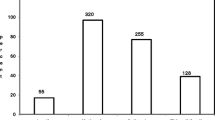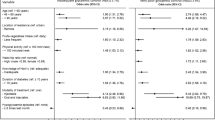Abstract
Background
Achievement of adequate glycaemic control is important to alleviate complications, improve quality of life and reduce mortality among persons with diabetes. This study estimated the level of glycaemic control and determinants of poor glycaemic control among persons with diabetes in a rural population of North India.
Methods
We randomly selected 245 persons aged ≥ 18 years with self-reported diabetes from the information of 100,000 individuals available in Health Information Management System of Health Demographic Surveillance Site (HDSS) Ballabgarh. Glycaemic control was assessed by measurement of glycated haemoglobin (HbA1c). Blood pressure, weight, height, waist and hip circumference were measured with standard procedures. Information regarding disease and treatment history was recorded.
Results
Mean age of participants was 56.2 (± 11.3) years. Mean HbA1c was 8.04% (± 2.54), with no significant difference across age and sex. Good glycaemic control (HbA1c < 7%) was observed in 41.3%. On multivariate logistic regression, duration of > 10 years since diagnosis of diabetes (OR = 2.71, 95% C.I. 1.08–6.81), and high serum triglyceride (OR = 2.17, 95% C.I. 1.19–3.98) levels were significantly associated with poor glycaemic control, while persons aged > 60 years were less likely of poor glycaemic control.
Conclusion
Achievement of adequate glycaemic control in this population is poor and warrants prompt interventions.


Similar content being viewed by others
References
Diabetes atlas. International Diabetes Federation. 2017. http://www.diabetesatlas.org/across-the-globe.html. Accessed 15 Jan 2018
IDF Diabetes Atlas Group. Update of mortality attributable to diabetes for the IDF Diabetes Atlas: estimates for the year 2013. Diabetes Res Clin Pract. 2015;109:461–5.
Beagley J, Guariguata L, Weil C, Motala AA. Global estimates of undiagnosed diabetes in adults. Diabetes Res Clin Pract. 2014;103:150–60.
Indian Council of Medical Research ICMR-India Diabetes [INDIAB] Study, final report (2008–2011). 2016. https://icmr.nic.in/sites/default/files/reports/ICMR_INDIAB_PHASE_I_FINAL_REPORT.pdf Accessed 15 Jan 2018
Kadam SS, Payghan BS, Mayuri Reddy R, Kumara Swamy RC. Role of social determinants in glycemic control of type 2 diabetic subjects. Int Res J Med Sci. 2014;2:2–6.
American Diabetes Association. Glycemic targets: standards of medical care in diabetes—2018. Diabetes Care. 2018;41:S55–64.
Ali MK, McKeever Bullard K, Imperatore G, Barker L, Gregg EW. Characteristics associated with poor glycemic control among adults with self-reported diagnosed diabetes—National Health and Nutrition Examination Survey, United States, 2007–2010. MMWR Suppl. 2012;61(2):32–7.
Altemani AH. The prevalence and determinants of poor glycemic control among adults with type 2 diabetes mellitus in Saudi Arabia. Diabetes Metab Syndr Obes. 2018;31(11):15–21.
Kant S, Misra P, Gupta S, Goswami K, Krishnan A, Nongkynrih B. The Ballabgarh Health and Demographic Surveillance System (CRHSP-AIIMS). Int J Epidemiol. 2013;42:758–68.
Krishnan A, Nongkynrih B, Yadav K, Singh S, Gupta V. Evaluation of Computerized Health Management Information System for Primary Health Care in Rural India. BMC Health Serv Res. 2010;10:310.
Chobanian AV, Bakris GL, Black HR, Cushman WC, Green LA, Izzo JL Jr, et al. The seventh report of the Joint National Committee on Prevention, Detection, Evaluation and Treatment of High Blood Pressure: the JNC 7 report. JAMA. 2003;289:2560–72.
International Obesity Taskforce. The Asia-Pacific perspective, redefining obesity. World Health Organization Western Pacific Region. 2000. http://www.wpro.who.int/nutrition/documents/docs/Redefiningobesity.pdf. Accessed 15 Jan 2018.
IDF Task Force on Epidemiology and Prevention. The IDF consensus worldwide definition of the metabolic syndrome. 2006. https://www.pitt.edu/~super1/Metabolic/IDF1.pdf. Accessed 15 Jan 2018
Expert Panel on Detection, Evaluation, and Treatment of High Blood Cholesterol in Adults. Executive summary of the third report of the National Cholesterol Education Program (NCEP) expert panel on detection, evaluation, and treatment of high blood cholesterol in adults (Adult Treatment Panel III). JAMA. 2001;285:2486–97.
Donnan PT, MacDonald TM, Morris AD. Adherence to prescribed oral hypoglycaemic medication in a population of patients with type 2 diabetes: a retrospective cohort study. Diabet Med. 2002;19:279–84.
Mohan V, Shah SN, Joshi SR, Seshiah V, Sahay BK, Banerjee S, et al. Current status of management, control, complications and psychosocial aspects of patients with diabetes in India: results from the DiabCare India 2011 study. Indian J Endocrinol Metab. 2014;18:370–8.
Menon VU, Guruprasad U, Sundaram KR, Jayakumar RV, Nair V, Kumar H. Glycaemic status and prevalence of comorbid conditions among people with diabetes in Kerala. Natl Med J India. 2008;21:112–5.
Nagpal J, Bhartia A. Quality of diabetes care in the middle- and high-income group populace: the Delhi Diabetes Community (DEDICOM) survey. Diabetes Care. 2006;29:2341–8.
Ramachandran A, Mary S, Sathish CK, Selvam S, Catherin Seeli A, Muruganandam M, et al. Population based study of quality of diabetes care in southern India. J Assoc Physicians India. 2008;56:513–6.
Ji LN, Lu JM, Guo XH, Yang WY, Weng JP, Jia WP, et al. Glycemic control among patients in China with type 2 diabetes mellitus receiving oral drugs or injectables. BMC Public Health. 2013;13:602.
Viana LV, Leitao CB, Kramer CK, Zucatti AT, Jezini DL, Felício J, et al. Poor glycaemic control in Brazilian patients with type 2 diabetes attending the public healthcare system: a cross-sectional study. BMJ Open. 2013;3:1–6.
National Center for Health Statistics. NHANES 2003–2004. Hyattsville, MD, U.S. Department of Health and Human Service, Centers for Disease Control and Prevention, National Center for Health Statistics. Available from www.cdc.gov/nchs/about/major/nhanes/nhanes03_04.htm. (updated 2016 May 18)
Landman GW, van Hateren KJ, Kleefstra N, Groenier KH, Gans RO, Bilo HJ. The relationship between glycaemic control and mortality in patients with type 2 diabetes in general practice (ZODIAC-11). Br J Gen Pract. 2010;60:172–5.
Kamarul Imran M, Ismail AA, Naing L, Wan Mohamad WB. Type 2 diabetes mellitus patients with poor glycaemic control have lower quality of life scores as measured by the Short Form-36. Singap Med J. 2010;51:157–62.
Nathan DM, DCCT/EDIC Research Group. The diabetes control and complications trial/epidemiology of diabetes interventions and complications study at 30 years: overview. Diabetes Care. 2014;37:9–16.
Turner R, Holman R, Stratton I, Cull C, Frighi V, Manley S, et al. Tight blood pressure control and risk of macrovascular and microvascular complications in type 2 diabetes: UKPDS 38. UK Prospective Diabetes Study Group. BMJ. 1998;317:703–13.
Raheja BS, Kapur A, Bhoraskar A, Sathe SR, Jorgensen LN, Moorthi SR, et al. DiabCare Asia—India Study: diabetes care in India—current status. J Assoc Physicians India. 2001;49:717–22.
Author information
Authors and Affiliations
Corresponding author
Ethics declarations
Ethical approval
Ethical clearance for the study was obtained from the Institutional Ethics Committee with the approval number IEC/NP-341/08.10.2014. This article does not contain any experiments done on animal or human subjects by any of the authors. This study contains data obtained from human subjects. Written informed consent was taken from the participant for inclusion in the study.
Conflict of interest
The authors declare that they have no conflict of interest.
Additional information
Publisher’s note
Springer Nature remains neutral with regard to jurisdictional claims in published maps and institutional affiliations.
Rights and permissions
About this article
Cite this article
Misra, P., Singh, A.K., Kant, S. et al. Glycaemic control among adults with self-reported diabetes in health and demographic surveillance site (HDSS) of rural North India. Int J Diabetes Dev Ctries 39, 707–714 (2019). https://doi.org/10.1007/s13410-019-00732-3
Received:
Accepted:
Published:
Issue Date:
DOI: https://doi.org/10.1007/s13410-019-00732-3




